Table of contents
- Driving Techniques in MotoGP: Then and Now That’s how the pros drive
- 1960s & 1970s
- 1970s & 1980s
- 1980s & 1990s
- The 21st century
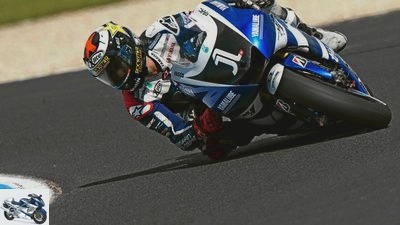
2Snap
Sports & scene
Motorsport
Report on driving techniques in MotoGP
Driving Techniques in MotoGP: Then and Now
That’s how the pros drive
Content of
The technical development and thus the driving style in the Grand Prix never stand still. From rear wheel drift to other scary tricks, PS shows how technical innovations have given riders ever wilder ideas.
Uwe Seitz
December 20, 2011
Motorcycle racing is different from most sports. Complex technology plays a major role. And when the machines change, so do the drivers. This is what the development of the most diverse riding styles in GP is all about: As motorcycles get better, riders learn new things or even use old tricks to gain an advantage. And every now and then there is this special driver who rearranges the game with his ingenuity.
The job of a racing technician, on the other hand, is pretty straightforward: He builds a motorcycle that goes as fast as possible in curves and straights. The engineers do not set out to develop a beastly engine or build a chassis that is as agile as an oil tanker. But that happens. Usually because it cannot be avoided. All the drivers can do is make the most of what you give them. Then, over the next few years, things are developed further and problems are resolved. There are new types of tires, different braking systems or frames, revolutionary plastics and different ignition sequences. The engines spin faster but are more controllable, the chassis stiffer and the tires have more grip.
Drivers who do more than be satisfied with what is available also change the rules of the game. And that’s why they become legends like Mike Hailwood, Kenny Roberts, Wayne Rainey, Mick Doohan and Valentino Rossi. All of these guys have taken the limit to a new level.
The irony: Today we are where we were before. During the 1960s, the racers drove precise arcs through the curves. Then the ballet-like U-line turned into an evil V. Today we got back to the U with electronically controlled 800 bikes. The only difference: the brutal speed, the breathtaking lean angle and the dragging elbows. How long will it be like this? History teaches us: with new technology and guys like Stoner probably not much longer.
1960s & 1970s
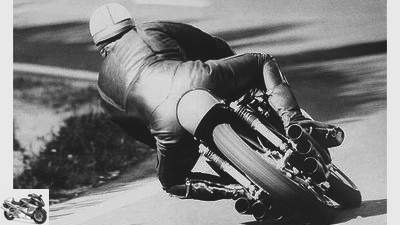
archive
With his tremendous driving talent, Mike Hailwood got the most out of classic style – until his toes were bleeding.
technology:
Disc brakes, aluminum rims, wide tires
driver:
Mike Hailwood, Giacomo Agostini
Half a century ago, racing drivers drove as conventionally as the normal road driver still does today. No hanging-off or knee-out. Of course they drove as fast as the technology of their time allowed. But the old GP boxes of the 60s had terrible brakes, little grip and a comparatively poor performance, which is why the heroes of that time simply let it run in the corners and concentrated on taking momentum with them. “It was about keeping the speed as possible, because you didn’t really have a brake or acceleration,” says three-time GP winner Mick Grant. In the age of soft frames and thin tires, the guys drove unspectacular lines. “Back then you pulled the brake when approaching the bend, slowly let it out on the way to the apex and slowly accelerated again from there. The curve up to the crown of the head was identical to the one out, ”says Peter Williams, who finished fourth in the 500 World Cup in 1967. “Not like today, when they quickly straighten the bike and then crank the gas to the max.”
A few guys had the superior MV Agusta, but they all ran on the same tires. “There was only the Dunlop Triangular,” says Williams. “So everyone was the same style. We tried to go completely round. ”And that stayed that way for a long time. The 60s legend Giacomo Agostini remembers having changed his driving style shortly before the end of his career in the 70s. “The motorcycles hardly changed, so there was no reason for big changes,” says the 15-time world champion. Hanging-off and weight-shifting were not only unnecessary, but also counter-productive. “If you only have 49 hp, you don’t have to put any weight on the front wheel when you accelerate,” laughs Grant. “It was the same when braking. Nothing was easy in the back. ”So the round riding style was called for, also because the frames were very thin and the suspension travel was zero, and the machines would not have reacted well to restlessness caused by drivers fidgeting.
Undoubtedly, engineers at the time were more concerned with other things than chassis design. At the beginning of the 60s, a Honda 125-GP-Twin had an output of 184 hp per liter. At the end of the decade, the two-stroke Yamaha V4-125 produced 340 hp per liter. There wasn’t much time left for the chassis. For the engineers, performance was everything – especially in Japan. “That was the big Japanese problem,” recalls Ago, who snatched the 500cc title away from Mike Hailwood on a Honda in 1966 and 1967 on a Honda. “When I drove for the title with Mike, the Honda had a lot of power, but the chassis was catastrophic.” This underlines Mike Hailwood’s brief comment when the Honda technicians asked him about the handling of the legendary six-cylinder 250: “Simply terrible! “
But when the tire and chassis development began, the driving style also changed. At the end of the 1960s, the first riders stuck their knees out, even if the reasons for this were different than today. “We slowly dragged the toes of our boots over the road to improve grip,” Williams recalls. “Hailwood drove the most crooked and sanded his boots until his toes were bleeding. To avoid that, we pulled our toes back to the inside of the notches, which turned the knee outwards. ”Williams also quickly enjoyed other innovations such as the first disc brakes, then aluminum rims, which allowed the drivers to do things to do that was impossible before. “The disc brakes kept the bike on course much better than drum brakes, which made it easier to brake into corners,” says Williams. “With the light, tubeless aluminum rims, there were less gyroscopic forces and the bikes were much easier to turn. In addition, the front did not react so wildly to any bumps, which is why you were faster in the corners. “
When rounder and wider tires finally appeared in the early 1970s, not only did speed increase, but they also had a radical influence on driving technique. Even Ago had to adapt to the knee-out generation. “I took my knee out because the motorcycles couldn’t be turned on the wide tires, suddenly you had to help with your body.”
1970s & 1980s
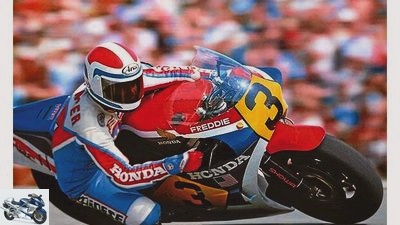
archive
Freddie Spencer on his Honda NS 500.
technology:
Slicks, radial tires, rotary valve and membrane control, long spring travel
driver:
Kenny Roberts, Freddie Spencer
When the big two-stroke engines came, everything changed. From the beginning of the 70s, the performance of the bikes soared that the tire and chassis engineers were completely taken by surprise. It would be a few years before they got it under control, so the drivers had to take care of themselves until then. The 500 and 750 cc gave their brutal performance so underhanded that the motorcycle itself was actually completely overwhelmed. At the beginning, the drivers did their best and applied their learned style of the “toothless” four-stroke engine. Then the Americans emerged who had learned their driving skills on dirt track ovals, but had little understanding of road racing until the early 1970s. “We didn’t really have any real street races,” says Kenny Roberts. “Only a handful of guys were even competitive in the dirt track and road races. When I started, I drove up and down like everyone else here. ”That didn’t feel good for the future King, however, and when GP genius Jarno Saarinen appeared in the USA in 1973, Roberts looked closely. “I watched him and wondered why he was hanging out like that. Then I tried it and immediately felt a lot better. “
By shifting their weight inward, the riders managed to turn the lumbering motorcycles much better. The “hanging out” also reduced the lean angle and thus allowed more cornering speed. Actually, that was the beginning of the driving tricks with which drivers gained advantages and responded to technical deficiencies.
Therefore, Roberts next used his dirt track technique on asphalt and sacrificed the speed at the entrance to the corner for higher speed at the corner exit. “I remember lapping multiple Daytona winner Dick Mann. Before a bend I caught up with him and was pretty shocked at how fast the guy drove in there. But at the end of the curve I almost popped into him because he was still driving so obliquely that he could hardly accelerate. “
The speed out of a curve is almost always more important than in, because the momentum is great to take with you on the next straight. That is why Roberts ’style developed into the ultimate, also because he“ drove around ”the problems with the chassis and the tires. “Back then there was only one effective way to turn a motorcycle quickly: slowly at the top, straighten up, straighten, accelerate.” This style had other advantages. Roberts ’reckless way of accelerating caused the rear wheel to spin, causing the bike to slip behind at the exit of the curve and align itself even faster.
In order to brake the bike down to the top, the American even slipped over the front wheel – as he had done on the dirt track. “It pushed right over the front, and I even turned the bike in slightly for more friction. That worked great, because if it threatened to slip away, your knee was already on the ground to save it. ”Instead of the dirt track steel shoe, the knee became like a fulcrum. “The hanging-off and the dragging knee made me feel the bike drifting.”
So Roberts turned the classic U into something like a radical V. Suddenly all talented racers drove such spectacular lines that now set them apart from normal road drivers by a world. And that’s the way it has remained to this day.
The further development of motorcycles did not stand still, however, because the manufacturers discovered the importance of chassis and tires. “In the 60s, it was all about how many cylinders you could screw on something like that,” laughs Roberts. “When I was driving, they switched from in-line to V-engines, they suddenly took care of the frames, dampers, forks and brakes, and the tires got better. After all, we were the first to bring the good-year slicks, and soon afterwards everyone had treadless tires. “
Mastering the insane two-stroke power output was a central task. Rotary valve technology was standard until Freddie Spencer chased off the title from Roberts in 1983 with the Honda NS 500 with diaphragm control. Soon everyone had the membrane solution.
The NS was not like the other 500s. She was nimble and friendly and allowed Spencer to do something that the others didn’t know before: “If I had too much weight in front, I would accelerate and shift it backwards until it slipped. So I moved back and forth in between. “
The diaphragm was just an evolution towards better control of power output, which allowed riders to push the limit even further with less risk. At the same time, the frames became stiffer and the suspension travel longer. “The first TZ bucked so brutally that you had to fight them,” recalls Roberts. “There were guys who drove them clean, but they were slow. The guys with the wildly shaking things won the races. I drove the TZ with a steeper steering head angle so that it turned faster. Instead, the thing wobbled like a cow’s tail. My tuner Kel Carruthers then drilled out the steering damper and poured in gear oil. The handlebars couldn’t be turned in the paddock, but that was the only chance to get the bike under control. When Yamaha brought longer dampers, everything became smoother and we were able to remove the steering dampers. The stiffer frame allowed a harder driving style over a longer period of time. Because when everything twists and turns, everything slips and rocks, then your physique sets the limits. ”The next big leap was radial tires. “The radial tires had a lot more grip and were much more stable. That made it possible to step on the gas very early, ”says Spencer.
1980s & 1990s
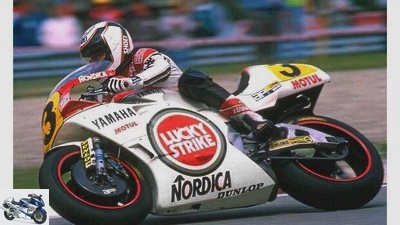
archive
Mick Doohan was the ruler in the 1990s. Nobody got along better with the 500 than the Australian with the crazy driving style.
technology:
Upside-down forks, carbon brakes, Big Bang ignition
driver:
Wayne Rainey, Mick Doohan
The technical improvements made it possible for the American and Australian invaders to elevate Roberts ’often uncontrolled slides to a true art form. The artists were Eddie Lawson, Wayne Rainey, Kevin Schwantz, Wayne Gardner, Mick Doohan, and a few others. But actually the bikes weren’t ready yet. Doohan’s 1989 NSR 500 was a cruel monster. “You could push the bike down, but it just wouldn’t turn, just go straight ahead. So you had to give in pretty early to hit the parting at all, ”recalls Doohan. “The engine was a beast too. You had to sideways out of the curve to stay on the track at all. The spinning rear wheel also felt safer than driving the tire on the edge and not knowing when it would smear. “
But development continued, and thanks to better chassis and tires, cornering speed was important again. Now the rule was: quick in, quick out. “Some people said I was going into corners too fast, but I wanted to get through them as fast as I could,” says Doohan. “I puked until I got the right front tires. As the rear tires got better, the fastest way to get through was in a clean line. In the end, across is not faster. A little oversteer helps when the track runs out, but for me the rear wheel brake is still the best way to prevent understeer. “
The better front tires didn’t just make the dirt track-savvy guys faster. They also allowed Europeans like Luca Cadalora and Alex Criville, who had learned their trade with 125 cc on the road, to be at the forefront of the 500 cc. These guys turned the V back into a U. “When Luca was my team partner in 1993, he was cornering really fast,” says Wayne Rainey. “He had a completely different style than me, he was Mr. Kurvenspeed. In 1988 he wouldn’t have had a chance with that, not with the tires back then. ”The dirt track faction still had the upper hand because their style still worked when the tires wore off.
In addition to the tires, there was another reason for the high cornering speed. Wayne Rainey: “When I rode the first Ohlins upside-down fork, it was so much stiffer that you had a direct line to the front tire. Once you moved the stub, the muddy feeling was just gone, and you could do everything a little later, for example, braking and turning. Carbon brakes were also something that made everything go faster. The motorcycle was more nimble and you didn’t have to drag it around so brutally. “
The brakes and forks were a big step up but wouldn’t have worked as well without a matching chassis. Fortunately, the factories recognized the importance of rigidity. “When they found out about it, you could take corners very quickly because the bike could take it,” says Rainey. “When I watch videos from back then, I see how my posture has completely changed, my legs, the flexion of my back, how I straighten my elbows and where my hands are. From my first year in 1988 to 1993 there were two totally different drivers at work. “
Rainey’s main focus was on a smooth power output where he accelerated at the exit of the curve. That was the crucial moment. If that works, there will be a few meters ahead. If it goes wrong, you fly a few meters through the air. “On the 500, it came down to doing everything at the exit of the bend,” says the three-time world champion. “If you turned in and the weight was on the front wheel, your life was in the hands of the motorcycle until you opened the gas again. I wanted an engine that responded very delicately and gently took the weight off the front wheel. From then on I was the boss in the ring again. Then it just mattered how far you can get it out of the curve until it slipped behind. A slight slide was all you needed to get out of the curve cleanly. If it didn’t slip because of too much grip, you just pushed it up again. But that was also dangerous because the flank was under tension and suddenly relaxed and really bounced back. ”There are impressive shots of such highsiders!
In 1992, Honda’s Big Bang ignition finally made things a little gentler – especially for Europeans. When the unleaded fuel came in 1998, things got a little tamer and the drivers were able to cock the taps even at a low angle. “Lead-free made the 500s into 250s,” Doohan recalls. “I really had to train myself to open the throttle even in an inclined position. A year earlier you would have been thrown off in a high arc. “
Bit by bit, the 500 series became a normal racing motorcycle that even normal riders could handle. But as always: the very clever drivers found ways and means to make the difference. -Rainey, for example, used the front brake to get through tight chicanes quickly. Towards the point exactly between the curves he braked heavily at the front, causing the bike to straighten up all of a sudden. (Please don’t copy it!) Garry McCoy’s method was even wilder: “I provoked a fast highsider in the middle of the chicane so that the bike threw me on the other side by itself.”
The 21st century
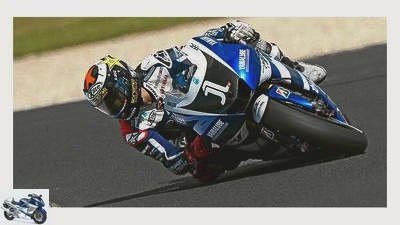
archive
Jorge Lorenzo was the king of the precise and ultra-fast U-Line in the 800s. Will slide again in 2012?
technology:
Four-stroke, traction control, Bridgestone slicks
driver:
Valentino Rossi, Casey Stoner
The 500s were soon quite well mannered machines, but their time was up. There were almost no civil two-stroke engines left, and so the Grand Prix had to adapt. Switching to MotoGP bikes was a blatant cut. Years of 500cc chassis experience came across big, friendly 990s engines. The driving style changed at the same time, but the biggest leap was yet to come. With the 990s, the wild V came back into play because they were simply so powerful – 230 hp compared to the 190 hp of the 500s. “When you have that much power, you have to concentrate as much on acceleration as possible. You don’t really have to think about cornering speed, ”says Valentino Rossi, the last 500cc and first MotoGP champion. “You set up the 990 as early as possible and place it on the fattest part of the tire,” analyzes Colin Edwards. “The things were just about making the straights longer than they actually were.”
With the 800s that was suddenly over. They had less torque, much better electronics and brand new tires. “With the 990 you ironed out a mistake. If you had to go far, you still had enough momentum that you couldn’t tell by the lap time, ”explains Edwards. “With the 800 you’re half a meter off the racing line – and that’s it.”
The 800s – and the Bridgestone tires – are a lot trickier because they allow a lot more cornering speed, which makes driving with millimeter precision necessary. And so the lines mutated again from V back to U. Not quite the elegant arches of the 1960s, but terribly fast corners driven with a lot of pressure – extremely violent: brake like a madman, let your leg hang for better lever and balance, brake full let out and immediately throw the bike into the curve at brutal speed. And under no circumstances should you brake at the rear – that’s why Superbike riders find it so difficult on the 800s.
“The Michelin style was: full pipe at the end of the curve – done,” says Rossi. “The Bridgestones have so much flank grip that you can drive a lot of cornering speed without sacrificing acceleration. In addition, the electronics have changed everything, because before that you had to take care of the slides and wheelies. Now you just need a good electronics man. “
It’s a common belief that electronics made MotoGP too easy. Edward’s statement even underlines this: “Today you are in the maximum incline and open the gas. It wobbles a little at the back. The electronics take care of you so well that the slight movements even take 10 to 15 degrees of the curve in one meter. If you tried that before, you were on your way to the moon. “
Traction control actually allows the good riders to get better. But if the electronics help the slower, the really fast guys will find the difference elsewhere. Because if MotoGP riders open the gas on a lean angle, they run into new problems: the rear end becomes unstable, making it difficult to hit the right line. Using the rear brake when accelerating is not exactly intuitive – but it works. The rear end is pressed against the ground, the tire bites into the asphalt and the contact surface becomes wider.
But there’s a worse problem with accelerating early. Opening the throttle valve at the apex suddenly means less pressure and thus grip on the front wheel. If it doesn’t slip, it at least makes precise steering difficult and ensures running wide, the motorcycle striving outwards. Most drivers struggle with this, so keep their hands off the throttle cable and sacrifice acceleration for steering. But the geniuses have found a solution for this. While you accelerate early, you gently apply the front brake, thus maintaining the pressure on the front wheel, creating grip and being able to steer. A risky but effective maneuver.
“It depends on the corner,” says Casey Stoner. “If the motorcycle is well tuned, you usually don’t need it. But every now and then it’s unavoidable. ”Now that the world champion is no longer sitting on the problematic Ducati, he plays with the Honda and does something on it that the others don’t:“ Many riders rely on cornering speed, but I like it prefer to straighten the bike and accelerate very hard. That’s why I use much less traction control than the others. “
So while Stoner changes the curve line, transforms it from a U to a V again, we can be sure that the others will follow suit soon – on the 1000s anyway. But today it’s not that easy, because the driving style doesn’t change with every year, with every weekend, but a few times per lap – high cornering speed there, with slides out there. “You can’t just drive the racetrack as you are used to, you have to drive it as it requires,” says Stoner. The Australian will also cope with the move to the 1000, which he believes the V variant will be even stronger. “I think the 1000s will change the style quite significantly. Getting through the corners quickly will still be important, but we’ll have to concentrate a lot more on exiting the corner again. ”We’ll see it soon and make the V for victory or anticipation.
Related articles
-
Driving report: Mercedes F 300 Life-Jet
motorcycles Driving report: Mercedes F 300 Life-Jet Driving report: Mercedes F 300 Life-Jet Wankomat Mercedes on a new path: The long-established company…
-
KTM RC 125 in the driving report
KTM 17th pictures BLACK&WHEEL! 1/17 KTM provides the Dukes with the RC series, also as 125, 200 and 390 and also produced in India. The premium in…
-
Honda motorcycles Driving report Honda CBF 125 Driving report Honda CBF 125 Feelings high at a low price Eleven hp and 127 kilograms. In addition, the…
-
Driving report Brough Superior S.P. 100
Kyoichi Nakamura motorcycles Driving report Brough Superior S.P. 100 Driving report Brough Superior S.P. 100 Rebirth A legend has resurrected: the famous…
-
Ducati Multistrada 1200 S in the driving report
Photo: Ducati 34 pictures Ducati 1/34 Ducati Multistrada 1200 S.. Ducati 2/34 Ducati Multistrada 1200 S.. Ducati 3/34 Ducati Multistrada 1200 S.. Ducati…
-
motorcycles Driving report Simson Star 50 Driving report, Simson Star 50 Simson Star 50 Thuringians are good at birds. After years of raising swallows,…
-
Driving report Kawasaki ZZR 1400
Nelson motorcycles Tourer Driving report Kawasaki ZZR 1400 Driving report Kawasaki ZZR 1400 (2006) American way of drive “America, you’re better off. ??…
-
Driving report Honda CBR 125 R
fact motorcycles Driving report Honda CBR 125 R Driving report: Honda CBR 125 R Honda has revised the CBR 125 R. Sponsored by Omi: The heavily…
-
Yamaha MT-03 in the driving report
Yamaha 15th pictures Yamaha 1/15 Blue skies, sunshine, empty streets. Do you need more sea? Nope. Yamaha 2/15 Yamaha MT-09. Yamaha 3/15 Yamaha MT-09….
-
Driving report Ducati Multistrada 1000 S
motorcycles Driving report Ducati Multistrada 1000 S Driving report Ducati Multistrada 1000 S Gold pen Ralf Schneider 08/03/2005 Slowly but surely the…